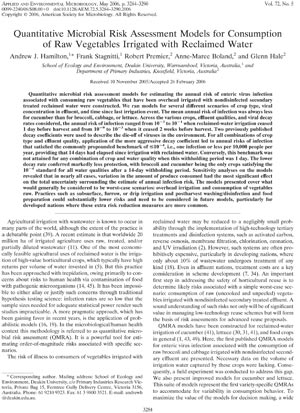|
|
Agricultural irrigation with wastewater is known to occur in many parts of the world. A recent estimate is that worldwide 20 million ha of irrigated agriculture uses raw, treated, and/or partially diluted wastewater. One of the most economically feasible agricultural uses of reclaimed water is the irrigation of high-value horticultural crops, which typically have high returns per volume of water invested in. But this practice has been approached with trepidation, owing primarily to concerns about risks to human health via contamination of food with pathogenic microorganisms. It has been impossible to either allay or justify such concerns through traditional hypothesis testing science: infection rates are so low that the sample sizes needed for adequate statistical power render such studies impracticable. A more pragmatic approach, which has been gaining favor in recent years, is the application of probabilistic models. In the microbiological/human health context this methodology is referred to as quantitative microbial risk assessment (QMRA). It is a powerful tool for estimating order-of-magnitude risks associated with specific scenarios. The risk of illness to consumers of vegetables irrigated with reclaimed water may be reduced to a negligibly small probability through the implementation of high-technology tertiary treatments and disinfection systems, such as activated carbon, reverse osmosis, membrane filtration, chlorination, ozonation, and UV irradiation. However, such systems are often prohibitively expensive, particularly in developing nations, where only about 10% of wastewater undergoes treatment of any kind The model presented here provides a useful starting point for managing risks associated with the spray irrigation of certain horticultural crops with secondary effluent. The model covers what would generally be considered to be worst-case scenarios: overhead irrigation and consumption of vegetables raw.
Abstract : Quantitative microbial risk assessment models for estimating the annual risk of enteric virus infection associated with consuming raw vegetables that have been overhead irrigated with nondisinfected secondary treated reclaimed water were constructed. We ran models for several different scenarios of crop type, viral concentration in effluent, and time since last irrigation event. The mean annual risk of infection was always less for cucumber than for broccoli, cabbage, or lettuce. Two previously published decay coefficients were used to describe the die-off of viruses in the environment. For all combinations of crop type and effluent quality, application of the more aggressive decay coefficient led to annual risks of infection that satisfied the commonly propounded benchmark of <104, i.e., one infection or less per 10,000 people per year, providing that 14 days had elapsed since irrigation with reclaimed water. Conversely, this benchmark was not attained for any combination of crop and water quality when this withholding period was 1 day. The lower decay rate conferred markedly less protection, with broccoli and cucumber being the only crops satisfying the 104 standard for all water qualities after a 14-day withholding period. Sensitivity analyses on the models revealed that in nearly all cases, variation in the amount of produce consumed had the most significant effect on the total uncertainty surrounding the estimate of annual infection risk. Practices such as subsurface, furrow, or drip irrigation and postharvest washing/disinfection and food preparation could substantially lower risks and need to be considered in future models, particularly for developed nations where these extra risk reduction measures are more common. Acknowledgments : This work was supported by Australian Research Council grant LP0455383. We acknowledge two anonymous growers; one allowed us to harvest the produce free of charge, and the other kindly donated the payment from our harvest to a charity. We also thank Susan Petterson, Hillel Shuval, and Charles Haas for valuable comments on a draft of this paper. We are grateful to David Vose for his advice and for suggesting the use of the -binomial dose-response model |
||||||||||||
|

